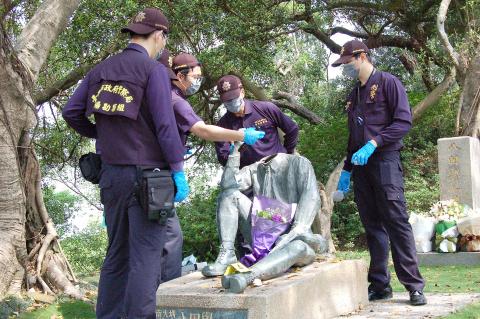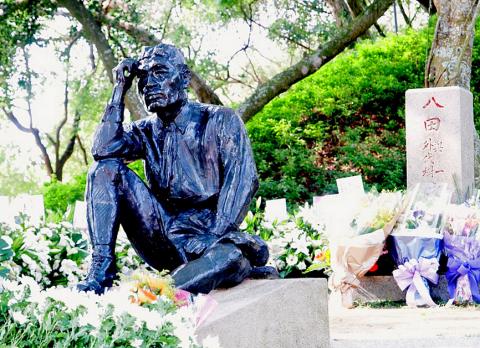A statue of Japanese engineer Yoichi Hatta near Tainan’s Wushantou Reservoir (烏山頭水庫) was found decapitated in an apparent act of vandalism, the Taiwan Chia-Nan Irrigation Association said yesterday.
Hatta is dubbed the “father of the Chianan Irrigation System” for his contributions to the development of irrigation in the Chianan Plain (嘉南平原) in southern Taiwan by building the Wushantou Reservoir during the Japanese colonial era.
An association member exercising in the area at about 6am saw that the statue’s head was missing, association president Yang Ming-feng (楊明風) said, adding that he told workers at the reservoir to call the police.

Photo: Wang Han-ping, Taipei Times
Police arriving at the scene surveyed the damage and collected information.
“The culprits of this violent act against Hatta’s memory should be strongly condemned,” Yang said.
The Tainan City Government issued a statement condemning the decapitation, saying that Tainan Mayor William Lai (賴清德) has instructed the city’s police department to form a task force to find the culprits.

Photo: Tsai Wen-chu, Taipei Times
A civil engineering graduate from then-Tokyo Imperial University (now the University of Tokyo), Hatta arrived in Taiwan in 1909 to serve at the civil engineering bureau, controlled by the Taiwan governor-general’s office.
In 1919, Hatta was tasked with designing an irrigation network for the Chianan Plain.
Following about 10 years of construction, Hatta’s team completed the reservoir in May 1930.
The reservoir has a capacity of 150 million cubic meters and can irrigate 100,000 hectares of farmland through a network of canals with a total length of 16,000km running through Chiayi and Tainan.
Hatta was killed in 1942, onboard a Japanese ship that was sunk in a submarine attack during World War II. He was on his way to Manila, where the Japanese government had sent him to develop agriculture in the Philippines.
His body was found, and after cremation, a portion of his ashes was taken to Taiwan for burial in a gravesite at the reservoir.
Following Hatta’s death, his wife, Toyoki Yonemura, remained in Taiwan. Heartbroken over the sudden and tragic loss of her husband, she committed suicide on Sept. 1, 1945, by jumping into the reservoir her husband had built.
The statue of Hatta was commissioned by the engineer’s aides and created by Japanese sculptor Yuma Tsukada of Kanazawa; it was shipped to Taiwan in 1931. However, local residents hid the statue for 40 years from 1941, fearing the Japanese government and later the Chinese Nationalist Party (KMT) government would want to melt down the statue for war materials and for political reasons.
Only when the political climate began to change in 1981 did the residents uncover the statue. It was reinstalled at the reservoir park.
On the anniversary of Hatta’s death on May 8 each year, the Chia-Nan Irrigation Association holds a memorial to honor his contribution in turning the Chianan Plain into Taiwan’s rice bowl.
Lai has asked the irrigation association to enlist professional help to repair the statue ahead of the event, the city government said.
Replacing the statue’s head should not be a problem, as the irrigation association had made a mold of the statue as a precaution, sources said.
News of the statue’s decapitation led to an outcry and speculation among local residents, with some accusing supporters of unification with China or people with anti-Japanese sentiments.
Some residents said Hatta’s legacy is apolitical and should not be used to incite hatred.
Former commissioner of then-Tainan county Su Huan-chih (蘇煥智) in a Facebook post called the decapitation “a deliberate act” adding that he believes the culprits targeted the statute to sabotage next month’s memorial service.
He said that people who vandalized the statues of Chiang Kai-shek (蔣介石) in “vigilante-like actions” have incited populist hatred and partisan acrimony in Taiwan, adding that all such actions should be condemned.

An essay competition jointly organized by a local writing society and a publisher affiliated with the Chinese Communist Party (CCP) might have contravened the Act Governing Relations Between the People of the Taiwan Area and the Mainland Area (臺灣地區與大陸地區人民關係條例), the Mainland Affairs Council (MAC) said on Thursday. “In this case, the partner organization is clearly an agency under the CCP’s Fujian Provincial Committee,” MAC Deputy Minister and spokesperson Liang Wen-chieh (梁文傑) said at a news briefing in Taipei. “It also involves bringing Taiwanese students to China with all-expenses-paid arrangements to attend award ceremonies and camps,” Liang said. Those two “characteristics” are typically sufficient

A magnitude 5.9 earthquake that struck about 33km off the coast of Hualien City was the "main shock" in a series of quakes in the area, with aftershocks expected over the next three days, the Central Weather Administration (CWA) said yesterday. Prior to the magnitude 5.9 quake shaking most of Taiwan at 6:53pm yesterday, six other earthquakes stronger than a magnitude of 4, starting with a magnitude 5.5 quake at 6:09pm, occurred in the area. CWA Seismological Center Director Wu Chien-fu (吳健富) confirmed that the quakes were all part of the same series and that the magnitude 5.5 temblor was

The brilliant blue waters, thick foliage and bucolic atmosphere on this seemingly idyllic archipelago deep in the Pacific Ocean belie the key role it now plays in a titanic geopolitical struggle. Palau is again on the front line as China, and the US and its allies prepare their forces in an intensifying contest for control over the Asia-Pacific region. The democratic nation of just 17,000 people hosts US-controlled airstrips and soon-to-be-completed radar installations that the US military describes as “critical” to monitoring vast swathes of water and airspace. It is also a key piece of the second island chain, a string of

The Central Weather Administration has issued a heat alert for southeastern Taiwan, warning of temperatures as high as 36°C today, while alerting some coastal areas of strong winds later in the day. Kaohsiung’s Neimen District (內門) and Pingtung County’s Neipu Township (內埔) are under an orange heat alert, which warns of temperatures as high as 36°C for three consecutive days, the CWA said, citing southwest winds. The heat would also extend to Tainan’s Nansi (楠西) and Yujing (玉井) districts, as well as Pingtung’s Gaoshu (高樹), Yanpu (鹽埔) and Majia (瑪家) townships, it said, forecasting highs of up to 36°C in those areas